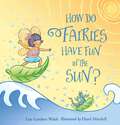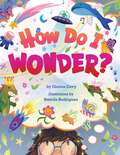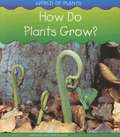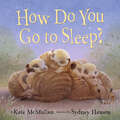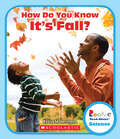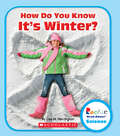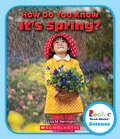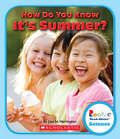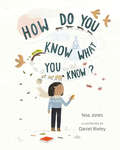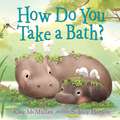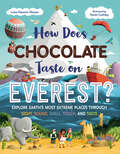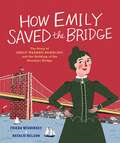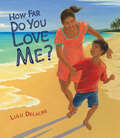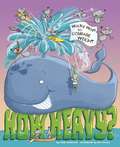- Table View
- List View
How Do Fairies Have Fun in the Sun?
by Liza Gardner WalshEveryone knows fairies are hard workers who look after the flowers and other growing things. But it can&’t be all work and no play. Do they ever get a vacation? How do they enjoy their favorite season, summer?Beloved fairy writer Liza Gardner Walsh explores the matter in a charming picture book of rhyming questions. Paired with warm and whimsical illustrations by Hazel Mitchell, this delightful book will help children discover just how fairies make the most of their busiest, most magical season of all. And while the fairies do love to add some fun to everything they do, there&’s also a gentle reminder here of our human connection to nature and the importance of nurturing it.
How Do I Wonder?
by Gianna DavyThrough lyrical text and vivid images, How Do I Wonder? invites young readers to open the door to their miraculous minds, exploring the wacky and wonderful 'What-ifs' and 'Whys' of the world around—and within—them."A thought-provoking tale with a much-needed message: The mind is a place of limitless wonders."—Kirkus Reviews A book can be a powerful tool to spark creativity and imagination. Do snails view turtles as slow? Why is water wet? From the author of No One Owns the Colors comes an entertaining and beautifully illustrated picture book that shows children how to ask questions that help them see the world in a different way. Written and illustrated for all children, each page showcases a diverse and engaging world and helps kids ages 4-8 develop a growth mindset. Let the silly prompts show how the joy of a simple question can entertain the mind and spirit, no matter where you happen to be. • Curriculum Connection—Creative prompts help open up pathways to discovery and spark a catalyst to classroom engagement. • Infinite Curiosity—Teach the innate sense of wonder that demonstrates joy is everywhere, not just in a certain place. • Evocative Words—The lyrical text is entertaining to read and the vivid imagery helps keep the curiosity in children flowing. Start helping your little ones see the world in a new way with How Do I Wonder?
How Do Plants Grow? (World Of Plants Ser.)
by Louise Spilsbury Richard SpilsburyLooking inside a seed. We'll look at a cut-open bean seed and talk about the food store and the baby plant and the seed coat. The baby plant in a seed stays safe and warm inside the seed coat until it is ready to start growing, usually in spring when the weather is warm and wet.
How Do Tornadoes Form?: And Other Questions Kids Have About Weather (Kids' Questions Ser.)
by Suzanne SladeWhat is the coldest place on Earth? How many kinds of clouds are there? Why do rainbows form? You’ve got questions about weather, and Kids’ Questions has answers!
How Do You Go to Sleep?
by Kate McMullanDiscover how different animals go to sleep in this rhyming picture book from a veteran children's author! Follow along as three children learn about the bedtime routines of squirrels, parrots, dolphins, and many more. Meerkats sleep in a stack. Is that how these kids go to sleep? Or do they hibernate in snow all winter long like frogs? Or maybe they sleep the day away like skunks? No, that can't be right! By the book's conclusion, the kids have imitated all kinds of animals who are portrayed sleeping in their natural habitats, thanks to Sydney Hanson's charming illustrations. Readers will recognize the way the human child eventually goes to sleep--with stuffed animals, a bedtime story, and a kiss good night!A Bank Street Best Book of the Year "Punctuated with zaniness, McMullan's litany nevertheless offers a quiet, calming rhythm to help little ones nod off."--Kirkus"A bedtime book that will soothe and please children and caregivers."--SLJ"A nice pairing with Diane Muldrow's How Do Giraffes Take Naps?, Vin Vogel's Bedtime for Yeti, or Cari Best&’s I&’m Brave! I&’m Strong! I&’m Five!, particularly for little ones looking for comfort around sleeping in their own beds."--Booklist
How Do You Know It's Fall? (Rookie Read-About Science: Seasons)
by Lisa M. HerringtonHow do you know its fall?Through vivid photos and engaging nonfiction text, this fun and fact-filled Rookie Read-About Science book answers the question, How do you know its fall? Covering everything from weather patterns to animal behaviors to seasonal activities, How Do You Know Its Fall? gives readers (Ages 6-7) an in-depth look at this season of change.
How Do You Know It's Winter (Rookie Read-About Science: Seasons)
by Lisa M. HerringtonHow Do You Know It's Winter?Through vivid photos and engaging nonfiction text, this fun and fact-filled Rookie Read-About Science book answers the question, How do you know its winter? Covering everything from weather patterns to animal behaviors to seasonal activities, How Do You Know Its Winter? gives readers (Ages 6-7) an in-depth look at this snowy season.
How Do You Know What Time It Is?
by Robert E WellsWhat would life be like with no clocks and no calendars? How would you know when to get up in the morning? How would you know when baseball season was about to start? Long, long ago, all people could do was watch the sun and moon and try to figure things out. Eventually, they made simple clocks like sundials. And as time marched on, people came up with more ways to measure it. Today, quartz crystal watches and atomic clocks tell us EXACTLY what time it is, at any moment, all over the world.
How Do You Know What You Know?
by Noa JonesA charming and inquisitive story that celebrates tracing the origin of ideas, language, and every day objects, for children 4–8.Where does snow come from? What language did the word thermos come from? And who was the Buddha's teacher?So many problems in the world come from accepting information at face value without looking into where it comes from. How Do You Know What You Know? follows a child and their father on a cozy, snowy day outing. The child asks questions about how things came to be the way they are. The questions range from how the father knows how to tie a shoe to why it&’s not a good idea to eat yellow snow. These queries are met by the father with patience and humor that weave a delightful narrative of intergenerational knowledge sharing. In this exchange, respectful inquiry is beautifully modeled for young learners.The journey includes an amble in the park, a trip to the library, a bus ride, and a visit to a local Buddhist temple where the father is a student. The teacher there introduces the child to the idea of lineage, that wisdom and understanding comes from generations of knowledge passed down from person to person. With a quaint and welcoming simplicity, the illustrations bring this beautiful story to life, and every spread has a subtle nod to the progression of how things come to be the way they are. The story encourages children&’s natural curiosity and shows them that everywhere they look there is a story to be told if we just ask.
How Do You Lift a Lion?
by Robert E WellsExplore the functions of levers, wheels, and pulleys, and learn how to lift a lion, pull a panda, and deliver a basket of bananas to a baboon birthday party!
How Do You Take a Bath?
by Kate McMullanPerfect for fans of Five Little Monkeys Jump in the Bath, this fun and educational picture book brings together adorable baby animals and bathtime.How do YOU take a bath? Does your mama comb your fur?Do you shake off all your dirt?Do you splash and flap and quack?Do the birdies peck your back?No!Follow elephants, pigs, monkeys, hippos, and more in this charming rhyming picture book from veteran author Kate McMullan. How does a pig take a bath? It sinks in the mud! What about a chicken? It thrashes about in dust! And a cat? Why, it licks itself clean, of course! Sydney Hanson's adorable illustrations toggle neatly between animals in nature grooming themselves and humorous depictions of children attempting the animals' bathing tactics. By the end of the book, the child finally makes his way to the bathtub, no mud baths or lick baths about it!
How Does Chocolate Taste on Everest?: Explore Earth's Most Extreme Places Through Sight, Sound, Smell, Touch, and Taste
by Leisa Stewart-SharpeAn immersive round-the-world adventure, where YOU are the explorer experiencing the most extreme places on earth and doing it all through your five senses.Have you ever wondered what the buzz of the rain forest sounds like on a trek through the Amazon? Or how it feels to experience the biting cold as you voyage across Antarctica? Or how chocolate tastes on Mount Everest? From every heart-bursting sight to tummy-lurching smell, you will experience them all–and do so without having to leave the comforts of your couch.This funny and fast-paced interactive thrill ride that young adventure-seekers are sure to enjoy is chock-full of facts, history, and survival tips peppered on every page.
How Does Our Food Grow
by Brooke JordenFruits and vegetables all taste great, but how did they end up on your plate? The fresh and colorful foods you know came from farms—that&’s where they grow! Some grow underground and some hang from trees. Can you find them all? Let&’s look and see! Every fruit, vegetable, grain, and legume has its own story: Where do they grow? How do they taste? And how do they impact our bodies and the world around us? In cooperation with Kitchen Connection, an organization committed to improving our food system through education, this colorful picture book introduces readers to the concepts of biodiversity, reducing food waste, and proper growing conditions for different crops in simple, accessible language. With cool facts and challenges throughout, fun rhyming verse, and charming illustrations, How Does Our Food Grow? tells the stories of more than a dozen of your favorite fresh foods. Knowing that our food choices make a difference in our health and the health of our planet empowers us to choose wisely. The more we know, the better we grow.
How Does a Smoke Detector Work?
by Liz HuyckEver wonder why a smoke alarm goes off? A battery, siren, and metal can work together to detect smoke and sound the alarm when catching a whiff of smoke.
How Electricity Gets from Power Plants to Homes (Here To There Ser.)
by Megan Cooley Petersonutilities; homes; community helpers; electricians; energy
How Emily Saved the Bridge: The Story of Emily Warren Roebling and the Building of the Brooklyn Bridge
by Frieda WishinskyThe amazing story of Emily Warren Roebling, the woman who stepped in to oversee the construction of the Brooklyn Bridge, which was completed in 1883.Emily was not an engineer, but she was educated in math and science. She married Washington Roebling, the chief engineer of the famous bridge. When Washington became ill from decompression sickness, Emily stepped in, doing everything from keeping the books, to carrying messages for her husband, to monitoring the construction of the bridge. She was the first person to cross the Brooklyn Bridge when it opened.Emily, who went on to study law among many other accomplishments, is an inspiration to all, as demonstrated through Frieda Wishinsky’s informative and engaging text and Natalie Nelson’s distinctive collage illustrations. Speech bubbles revealing imagined dialogue add a playful note to this historical account, which includes fascinating facts about the Brooklyn Bridge and a further reading list.Key Text Featuresfurther readingspeech bubblesCorrelates to the Common Core State Standards in English Language Arts:CCSS.ELA-LITERACY.RL.2.1Ask and answer such questions as who, what, where, when, why, and how to demonstrate understanding of key details in a text.CCSS.ELA-LITERACY.RL.4.3Describe in depth a character, setting, or event in a story or drama, drawing on specific details in the text (e.g., a character's thoughts, words, or actions).
How Far Do You Love Me?
by Lulu DelacreThis unique bedtime book by award-winning author-illustrator Lulu Delacre features a game that highlights the universal love between caregivers and children while taking readers on a journey across the seven continents of Earth.How far do you love me?I love you to the top of the peakslit by the morning sun ...To the crests of the desert where the wind sweeps sand from the dunes ... Based on a bedtime game that author-illustrator Lulu Delacre played with her young daughters, How Far Do You Love Me? is an "I love you" book with a twist. With every expression of love, readers visit a different location around the world, each a beautifully illustrated scene of caregivers and children in a place of natural beauty. The intimate size of the book is just right for sharing and snuggling up close with a child. As bedtime--or any quiet time--approaches, gather close with a special person in your life and get ready to let your imagination soar to place after place as you embark on a game of "How far do you love me?" The possibilities are endless!
How Hearing Works (Our Senses)
by Sally MorganIntroduces the sense of hearing, including how the ear functions, why hearing is important, and how the sense differs between humans and animals. Picture captions and descriptions present.
How Heavy?: Wacky Ways To Compare Weight (Wacky Comparisons Ser.)
by Mark WeaklandCompares various heavy objects to lighter objects in unique, illustrated ways.
How Heavy?: Wacky Ways To Compare Weight (Wacky Comparisons)
by Terry Flaherty Bill Bolton Mark Weakland Advocate-Art StaffCompares various heavy objects to lighter objects in unique, illustrated ways.
How High Can a Dinosaur Count?: ...and Other Math Mysteries
by Valorie FisherBelieve it or not, once Bessie balanced a tower of 8 beets. But today, when she tries to balance 8 beets . . . 3 fall. How many beets does Bessie balance today?A clever text and imaginative art mesh to create playful, simple math problems right on target for ages 5-99 . . . anyone who loves the magic of numbers! In this School Library Journal Best Book of the Year, budding young mathematicians can help Heloise add her dimes, nickels, and pennies to see which hat in Madame Millie's Hat Shop she can buy. Or they can tell time with Lulu at the Tutti-Frutti Zoo, where Lollipop Licking begins at 9:00 sharp.From the Hardcover edition.
